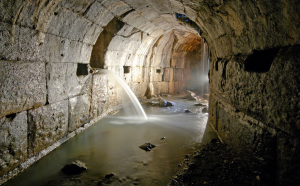Surprise Tampa Bay – Plumbers Have Saved More Lives
Modern Plumbing Has Eradicated More Disease and Saved Millions of Lives
Where There is Poor Plumbing People Die
 Before Modern Plumbing
Before Modern Plumbing
After the fall of the Roman Empire, Europeans despised all things connected to the Roman Empire. This included bathing. In most of Europe, there was a widespread belief that getting wet caused illness. This contempt and fear of bathing persisted through most of the Dark Ages.
Some Europeans actually defied customs by bathing, and it was usually done over great protest. When Queen Elizabeth bathed, her servants panicked, fearing she would become ill and die.
The European’s resistance to bathing was brought to America, influencing habits all the way into the 19th century. Philadelphia, in 1835, almost passed a law forbidding wintertime bathing. In 1845, ten years later, the city of Boston actually outlawed bathing, except by medical directive. This Boston law was not widely enforced, but it does illustrate the American resistance to bathing as late as the middle part of the 19th century.
Modern Plumbing Has Eradicated Disease
Before plumbing, indoor facilities consisted of a washstand, a washbowl, a pitcher, and a chamber pot or commode. Human waste was thrown into the street or anywhere it was convenient.
The lack of sanitation in urban areas filled with rats and vermin. This provided the perfect environment to spread disease. The Black Plague killed between 75 million to 200 million people. This was 1/3 of Europe’s entire population. Today, this disease is still not entirely eradicated, but human infection has become a rare occurrence. Between 1918 – 1919, it is estimated that 21.5 million people died because of the influenza pandemic. In the United States alone, 675,000 Americans died.
Plumbing and Polio
Polio is easily transmitted in human waste. It thrives in fecal matter. Plumbing infrastructure and water sanitation in India is way behind the rest of the industrialized world. In areas throughout the world where sanitation and hygiene are good, polio is extremely rare. Still to this day, in areas throughout the world where sanitation primative and hygiene are poor, the disease of Polio can spread rapidly.
Recently, immunization has received a lot of publicity and has garnered most of the credit for India being declared “polio free” by the World Health Organization. As recently as 2009, India has reported well over 700 cases of polio. and at that time, this made India the polio capital of the world. Although, in 2014, there were no documented cases of polio. But without proper sanitation, there is no way this will last. Vaccines alone will not stop polio. Modern plumbing and sanitation is mandatory.
A Breeding Ground for Polio
India is the second most populous nation in the world, with a population of 1.2 billion people. Currently, over half of the country of India, 780 million Indians, do not have a toilet. Over 96 million Indians do not have access to clean drinking water. In the rural areas of India, open defecation is still more common than attempting to dispose of human waste in a more sanitary fashion, like burying it.
There are efforts to improve sanitation and the plumbing infrastructure, but they pale in comparison to the extensive efforts to vaccinate Indians. Over 9 billion dollars have been spent on vaccinations for the people of India. In some parts of India, children have received as many as 30 doses of the oral polio vaccine before their fifth birthday. Bill Gates, the World Health Organization, and GAVI have ardently been pushing vaccines on people who still don’t have access to clean drinking water or the sanitary means to dispose of their human waste. Both plumbing and educating the people of India are needed.
Currently, the polio vaccine campaign in India is highly controversial because of the high rate of vaccine injury and death. There were 53,000 cases of NPAFP, a non-polio acute flaccid paralysis, among those vaccinated. NPAFP is a disease that is clinically indistinguishable from polio and twice as deadly that is caused by the live, weakened, polio viruses in the vaccine. Incidences of the disease rose and fell with the number of doses of the vaccine administered. To call this disease anything other than polio is semantic subterfuge, a whitewash for Big Pharma’s image.
More lives would be saved, and it would be far more effective if India’s water infrastructure and plumbing was improved.
London and Cholera
The European infant mortality rate was very high in the 18oo’s. It was from 25% to 70%. In the early-to-mid 1800s, London had little in the way of plumbing. The majority of people used town pumps and communal wells to get their drinking water. Waste disposal was far from adequate. Most of the people in London dumped raw sewage and animal wastes into open pits known as “cesspools” or directly into the Thames River. Unfortunately, the Thames River was also the source of drinking water.
Cholera spreads quickly and easily through contaminated water. It kills very quickly. Often, it proves fatal within hours of the first symptoms of vomiting or diarrhea.
In 1854, an outbreak of cholera struck London, claiming the lives of tens of thousands of people in England. In Soho, a suburb of London, there were more than 500 fatal cases of cholera in just more than a week.
Dr. John Snow, who lived near Soho, was able to investigate what was causing the outbreak of cholera in London. Just 5 years earlier, Dr. Snow had written an article on what he thought was the cause of cholera. It was in the water, and that is how it was spreading he argued. This idea was completely counter to the conventional wisdom of his time. In the 1850s, doctors believed that bad vapors, or a “miasma in the atmosphere” caused the cholera disease. Dr. Snow challenged this belief.
Tracing Cholera To the Source
Dr. Snow traced the cholera outbreak to the Broad Street pump. He convinced the town officials to remove the pump handle. The cholera outbreak abruptly ended. Sometime later, the cholera outbreak was traced to a woman cleaning a dirty diaper in the well on Broad Street.
Dr. Snow convinced the people of London that fecal matter was contaminating the water supply. Today Dr. John Snow is widely regarded as the father of epidemiology.
The Dysentery Epidemic, and Poor Sanitation
In 1994 Rwandan refugee camps in Zaire had outbreaks of dysentery. Plumbing did not exist and sanitation was poor. The Rwandan refugees defecated openly in common areas. Human waste was built up in the same areas where the refugees drew water that was used for cooking and drinking. Heavy rain flooded the area and dysentery became an epidemic, at its peak it was killing as many as 2,000 people a day.
Refugee camps are a haven for disease. This is directly related to poor sanitation and the lack of plumbing. Once the United States and UN officials brought in purified water to Zaire for the Rwandan refugees and encouraged people to use outhouses and latrines for defecation, the incidences of dysentery plummeted.
Population Overload
In America, the Industrial Revolution caused rapid population growth. Chicago’s population grew from 350 in 1835 to more than 60,000 by 1850. Chicago’s water infrastructure and plumbing weren’t designed to handle such a fast rise in population. During that time, Chicago was dealing with many different diseases. It had an especially high rate of typhoid fever. The source of the rapid increase in typhoid fever was traced directly to the city’s water and sanitation.
Most of the city’s sewage was going into the Chicago River, which flowed into Lake Michigan. Lake Michigan provided the Chicago’s drinking water. This contaminated the drinking water and created a cycle of disease and the widespread of typhoid fever.
It took many years to solve Chicago’s disease problem, but in the early 1900’s Chicago modernized their plumbing and water infrastructure. Chicago reversed the flow of several rivers and streams. As a result, typhoid fever and all other infectious diseases decreased tremendously.
Plumbing is the Answer
Modern plumbing and sanitation prevent the spread of disease. None of this is new information. Moses taught the people of Israel about sanitation. Moses made many rules for encampments. The Greeks and the Romans created elaborate plumbing systems of aqueducts, baths, and drainage. When the Roman Empire fell, plumbing and sanitation became a lost art. Civilization paid the price. Millions of people in the world died because of it.
Smallpox continued to infect Europe’s population until plumbing infrastructure became commonplace.
Most people in developed countries have access to modern plumbing. This is because of plumbers.
While medical professionals and pharmaceutical companies are quick to take credit for our increased life expectancy, in truth, they are not the only heroes. The work that plumbers do every day saves lives and stops the spread of disease.
Have you thanked a plumber?






